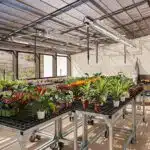Many times, the benefit of a skylight or glazed structure is that you can get light and warmth from the sun to help offset the costs of electricity and heating oil.
Working in an industry that uses glass and polycarbonate for structures and openings in the roof, we know a lot about heat gain and heat loss. It’s a big concern for almost all of our customers, especially when considering the impact on the environment and energy usage.
What is solar heat gain and heat loss?
Heat loss, measured in kW or BTUs, reflects the total transfer of heat through the fabric of the building from the inside out. Since we manufacture structures from aluminum and glass or polycarbonate, the information in this article will deal only with these elements. Although heat loss and heat gain can happen through any part of the building’s envelope.
The opposite of heat loss is heat gain, also referred to as solar gain. Heat gain occurs when warmth comes into the space via radiant heat as the sun shines through the glass. It’s also a sign of a low U-value rating. Heat gain also occurs as cool air escapes through seals.
Knowing what heat loss and heat gain is, how to reduce it, and what it means when specifying the type of glazing for a skylight, solarium, greenhouse, or the like, will help to answer many questions about the internal building environment.
Many times, the benefit of a skylight or glazed structure is that you can get light and warmth from the sun to help offset the costs of electricity and heating oil. It’s true that in Northern climates the heat gain can help other heating systems perform better, increasing overall comfort in a room. But for the glazed structure to actually be of benefit to keeping a room comfortable, the glass or polycarbonate must provide enough heat gain to offset any heat loss – through the same glazing.
How is solar heat gain and heat loss calculated?
As mentioned above, heat loss is measured in kWs or BTUs and is a function of heat transfer rates.
Heat transfer rates are measured in U values. The U value is the overall heat transfer coefficient and indicates how well glazing will heat. A low U value signifies glass that transfers less heat whereas a high value indicates that the glass is not going to perform well thermally.
The opposite or reciprocal of the U value is the R-value. R values are commonly used with rating types of insulation but can also be applied to the glazing.
The solar heat coefficient is the fraction of incident solar radiation admitted through a window, both directly transmitted and absorbed and subsequently released inward. The solar heat gain coefficient is expressed in a number between 0 and 1. The lower a window’s solar heat gain coefficient, the less solar heat it transmits.
So if you have a product with a low U value and high R value you can be sure it has less heat loss and will then help keep the room warmer. If you have a lower solar heat gain coefficient, the glazing will gain less heat, thus it helps keep the room cooler.
From breakfast nooks to fully functional living rooms, a conservatory-style solarium will provide a beautiful aesthetic from the outside, enhancing your home’s value and eye appeal.
One of the many unique features of a Sunshine Room is the ability to have “curved” eaves. Eaves are where the walls meet the roof. With a curved eave, there is no segmentation at the eave, the glass is curved to meet the roof.
Once you’ve decided which design is best for your home, it’s time to think about how to make your room the most comfortable and durable considering your geographic location. Watch for our next article in this series for more information.
Related Posts
We Like to Hear From You!
We service and support the products we manufacture and install. If you need assistance with
our products or those of another sunroom manufacturer, contact us!





